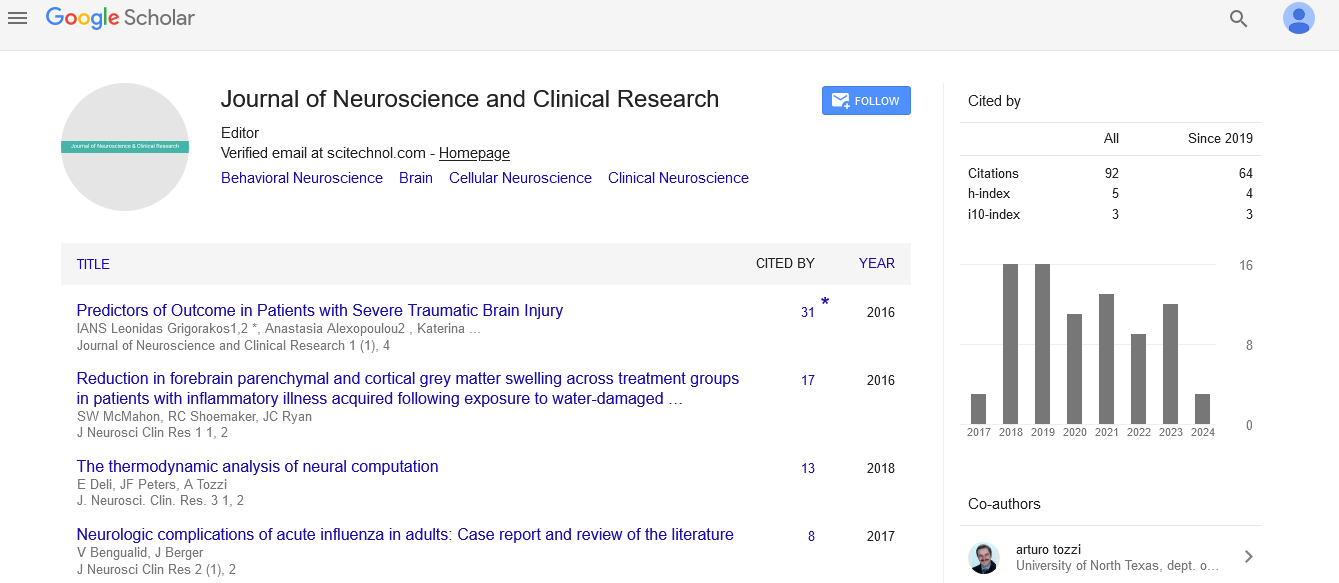Perspective, J Neurosci Clin Res Vol: 9 Issue: 2
Neuroplasticity: Mechanisms and Clinical Implications
Minerva McGonagalldo*
1Department of Psychiatry, Medical University of Gdansk, Gdańsk, Poland
*Corresponding Author: Minerva McGonagalldo,
Department of Psychiatry,
Medical University of Gdansk, Gdańsk, Poland
E-mail: mmcgonagalldo@gmail.com
Received date: 28 May, 2024, Manuscript No. JNSCR-24-137123;
Editor assigned date: 30 May, 2024, PreQC No. JNSCR-24-137123 (PQ);
Reviewed date: 14 June, 2024, QC No. JNSCR-24-137123;
Revised date: 21 June, 2024, Manuscript No. JNSCR-24-137123 (R);
Published date: 28 June, 2024, DOI: 10.4172/Jnscr.1000196
Citation: McGonagalldo M (2024) Neuroplasticity: Mechanisms and Clinical Implications. J Neurosci Clin Res 9:2.
Description
Neuroplasticity, the brain's remarkable ability to reorganize itself by forming new neural connections, is a cornerstone of modern neuroscience. This adaptive capability underlies learning, memory, and recovery from brain injuries, making it a critical area of study for understanding and treating various neurological conditions. This article delves into the mechanisms of neuroplasticity and explores its profound clinical implications. Neuroplasticity occurs at multiple levels, from cellular changes to large-scale cortical remapping. Key mechanisms include synaptic plasticity, neurogenesis, and functional reorganization.
This is the ability of synapses, the connections between neurons, to strengthen or weaken over time in response to increases or decreases in their activity. Long-Term Potentiation (LTP) and Long-Term Depression (LTD) are two primary processes. LTP enhances synaptic strength and is important for learning and memory, while LTD decreases synaptic efficacy, which is important for forgetting and finetuning neural networks. Contrary to long-held beliefs, the adult brain can generate new neurons, primaril in the hippocampus, a region associated with memory and learning. Neurogenesis plays a role in cognitive functions and has been linked to mood regulation, suggesting potential therapeutic targets for conditions like depression and anxiety. This involves the brain's ability to redistribute functions to different areas, often observed following injury. For instance, after a stroke damages the motor cortex, other parts of the brain may adapt to take over the lost functions, enabling partial recovery of movement and coordination.
Understanding neuroplasticity has profound implications for various clinical practices and therapeutic interventions. Neuroplasticity is pivotal in post-stroke recovery. Rehabilitation strategies, such as Constraint-Induced Movement Therapy (CIMT) and repetitive task training, leverage the brain's ability to reorganize and form new pathways to restore lost functions. Early and intensive rehabilitation is critical to maximize plasticity and functional recovery. Neurodegenerative Diseases: In conditions like Alzheimer's and Parkinson's disease, enhancing neuroplasticity could potentially slow disease progression and alleviate symptoms. Cognitive training, physical exercise, and certain pharmacological agents are being investigated for their ability to promote plasticity and support brain health.
Mental health neuroplasticity is also crucial in treating mental health disorders. Cognitive-Behavioral Therapy (CBT) and other psychotherapies can induce plastic changes in brain circuits, helping to rewire dysfunctional thought patterns and behaviors. Additionally, neuroplasticity-targeting medications, such as Selective Serotonin Reuptake Inhibitors (SSRIs), contribute to structural and functional brain changes that underlie their therapeutic effects. Learning and Development: In educational settings, strategies that promote neuroplasticity can enhance learning outcomes. Techniques such as spaced repetition, multisensory learning, and interactive environments can strengthen neural connections and improve cognitive abilities in both children and adults.
Chronic pain involves maladaptive plastic changes in the brain's pain processing pathways. Treatments that target neuroplasticity, including mindfulness meditation, graded motor imagery, and certain types of physical therapy, can help remodel these pathways and reduce pain perception. The future of neuroplasticity research holds great promise for developing novel therapeutic approaches. Advances in neuroimaging and electrophysiological techniques are providing deeper insights into the dynamics of brain plasticity. Furthermore, emerging fields such as optogenetics and brain-computer interfaces are exploring new ways to modulate neural activity and promote beneficial plastic changes.
Conclusion
Neuroplasticity is a dynamic and fundamental property of the brain that has far-reaching implications for understanding and treating neurological disorders. By harnessing the brain's inherent ability to adapt and reorganize, we can develop more effective therapies and improve outcomes for patients with a wide range of conditions. Continued research into the mechanisms of neuroplasticity and its clinical applications will undoubtedly lead to new breakthroughs in neuroscience and medicine.
 Spanish
Spanish  Chinese
Chinese  Russian
Russian  German
German  French
French  Japanese
Japanese  Portuguese
Portuguese  Hindi
Hindi 